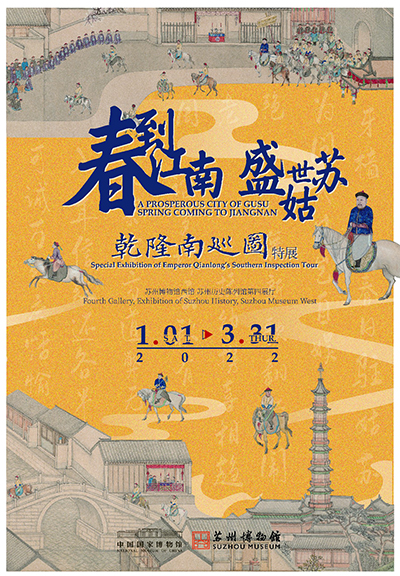The NMC has always attached great importance to strengthening cooperation with museums both at home and abroad, exploring the establishment of long-term cooperation mechanisms on an equal and mutually beneficial basis, and continuing to follow the principle of “putting exhibitions before collections and seeking mutual benefit through open cooperation.”
The exhibition “The Brilliant Paintings in Royal Garden: Court Paintings of Qing Dynasty from the National Museum of China” jointly held by the NMC and the Suzhou Municipal Culture, Radio, Television and Tourism Bureau opened to the public at the Suzhou Museum West.
It is particularly worth mentioning that “Stopover at Gusu,” the sixth volume of Emperor Qianlong’ s Southern Inspection Tour painted by court painter Xu Yang, one of the NMC’s most important collections, also journeyed to Suzhou. It was on display at the special exhibition “A Prosperous City of Gusu and Spring Coming to Jiangnan: Special Exhibition of Emperor Qianlong’s Southern Inspection Tour” at the Suzhou Museum West.

Outstanding literary and artistic works reflect the cultural creativity and development of a nation and its people, and can best represent the style and lead the trend of an era. China has a long history of painting and calligraphy, leaving us a large number of invaluable works that make precious contributions to the spiritual wealth of the Chinese nation. The Qing court paintings featured rich content and unique artistic styles, which embodied the official aesthetic values represented by the Qing Dynasty’s royal family and penned a splendid page in the development history of Chinese painting.
The peak development period of Qing court paintings was during the reigns of the Kangxi, Yongzheng and Qianlong emperors. With strong support from the state, institutions creating court paintings were well-developed and gathered a large number of painters, including a number of Europeans. These Western artists introduced focal perspective into the creation of court paintings, integrating their techniques with traditional Chinese artistic skills and forming well-structured, exquisite, and magnificent works.
The exhibition “The Brilliant Paintings in Royal Garden: Court Paintings of Qing Dynasty from the National Museum of China” jointly held by the NMC and the Suzhou Municipal Culture, Radio, Television and Tourism Bureau is aimed to deeply explore the collection resources of the NMC, display the outstanding artistic achievements of ancient Chinese calligraphy and painting, and reveal the important role of artistic works in leading historical trends.
A total of 27 paintings and calligraphy works collected at the NMC are exhibited, covering works by members of the royal family, court painters and civilian court officials skilled at painting. The exhibition is divided into three parts to present a comprehensive view of court paintings at that time. On the one hand, Qing court paintings involved a wide range of subject matters, with a particular focus on documenting major historical events and figures. Featured in the exhibition, the Emperor Qianlong’s Southern Inspection Tour painted by court painter Xu Yang is an outstanding example. On the other hand, Qing court painting also presented a perfect combination of Chinese and Western artistic skills.
In addition, the works by Emperors Kangxi, Yongzheng, and Qianlong, and other members of the imperial family, as well as scholars and government officials such as Wang Yuanqi, Jiang Tingxi, Dong Bangda, and Qian Weicheng, displayed in this exhibition show that the court paintings of the Qing Dynasty draw from and build upon the traditional styles of Chinese poetry, calligraphy, and painting, especially academic-style painting.
Related: